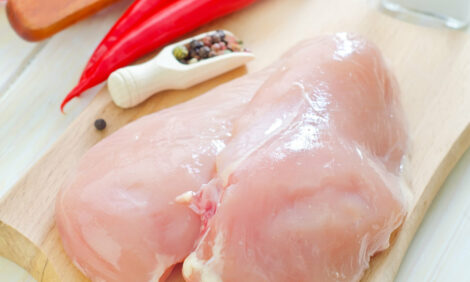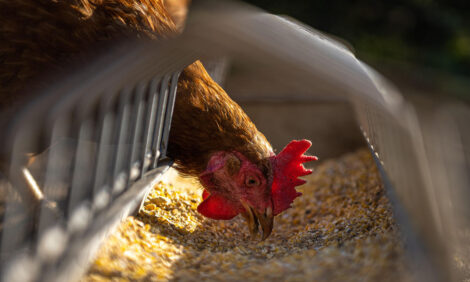



MARCH 2017 - How to Put Your Poultry on an Organic Diet
Robert Blair, Professor Emeritus in Animal Science at the University of British Columbia, Canada, has written several textbooks on the nutrition and feeding of organic livestock.He has just completed A Practical Guide to the Feeding of Organic Farm Animals, which aims to translate the science of feeding organic livestock and summarise it into practical guidance for farmers and producers.
The Poultry Site’s Editor, Alice Mitchell, spoke to Professor Blair about the differences between feeding organic and conventional poultry, and some of the latest developments in poultry feed, such as the use of insects.
How do organic poultry producers ensure their feed fits with the principles of protecting the environment for future generations?
Only those feedstuffs meeting organic standards are permitted in organic diets. No genetically modified types are allowed. Organic farming also attempts to be as sustainable as possible and to have a low impact on the environment.
One of the aims of organic farming is to raise the animals in as natural a way as possible and to integrate the herd or flock into the other farm activities, purchasing only a minimum of feedstuffs not produced on the farm. Feed still has to supply all the necessary nutrients otherwise productivity is lower and the animals would suffer from malnutrition.
Organic feed is more expensive than conventional feed because of the higher costs of organic feedstuffs, which are in short supply due to the increasing acreages of GM crops worldwide.
Does consumer preference provide an incentive for producers to feed poultry in an environmentally friendly way?
Consumers like to see farm stock out in the fields, enjoying the fresh air and sunshine and expressing their natural behaviour. Organic producers are aware of this and have tailored their regulations to try and meet these expectations.
How are organic feedstuffs regulated, and how can these standards be improved?
Each country has its organic regulations and standards, and organic products must be certified as organic by certification agencies.
Some consumers would like to see an actual testing programme introduced to prove that an organic product (such as eggs or milk) was produced from livestock raised organically, but such a test is at present not feasible.
Many in Europe’s poultry industry, even within conventional poultry farming, are concerned about the use of large amounts of imported soybeans, and the impact this has on sustainability. What do you think would be a good alternative or mitigation to improve matters?
Soybeans and soybean meal (fat-extracted soybeans) are generally the best protein supplements for livestock feeding. However, these are expensive imports in countries that are unable to grow soybeans, and also the organic types are in short supply because most of the soy being grown worldwide is GM.
An interesting development with soybeans is the introduction of plants suitable for cultivation in cooler climates – for instance the Maritime region of eastern Canada. This development, together with the installation of co-operative extruder facilities to process the soybeans, allows the crop to be grown and utilised locally. This could help regions that are deficient in protein feedstuffs to become self-sufficient in terms of fulfilling their feed needs.
Other protein-feed crops can also be grown and are being utilised as alternatives to soy, such as canola, field peas, field beans and sunflowers among others.
Allowing pure forms of amino acids in organic feeds, as has been done in several countries, helps to utilise scarce protein supplies more effectively and reduce pollution from excessive nitrogen in manure.
How does the process of feeding poultry differ between organic and conventional farms?
Organic feed can be fed in the same way as conventional feed, except that in organic production we try to maximise the use of whole grain. This generally requires the use of more feeders to allow the whole grain and other feed components to be fed separately.
The bird has a digestive system designed to digest whole seeds, therefore it seems unnecessary to feed it a pre-ground diet. This is what I recommend in organic poultry production.
Feeding whole grain also presents energy savings in feed preparation. The process of grinding requires about 20kWh per tonne of grain, whilst pelleting requires a large input of electrical energy amounting to approximately 10 per cent of the total feed costs and additional energy is required to generate steam for the steam-pelleting process.
Another advantage of whole grain feeding is that it has been shown to result in health benefits. It reduces leg and skeletal problems through a reduction in early weight gain and by promoting a better-developed gizzard, which appears to act as a barrier organ that prevents pathogenic protozoa (which cause coccidiosis) and bacteria from entering the lower digestive tract.
Are there other differences between the health status of organic and conventional poultry?
Organic production has some positive effects on bird health, and some negative effects. For instance, many producers use heritage breeds and strains that have a much lower incidence of health problems such as ascites (water-belly) and sudden-death syndrome (SDS) than found with commercial meat breeds.
Nearly all synthetic animal drugs used to control parasites, prevent disease, promote growth or act as feed additives in amounts above those needed for adequate growth and health are prohibited in organic poultry production. However, it is recommended to use similar vaccination measures to conventional poultry where allowed under the local organic regulations, against a variety of diseases such as Marek's disease, Newcastle disease and infectious bronchitis.
A main health problem in poultry is gastrointestinal disease. Relevant approaches to this problem in organic production include the enhancement of immunity, using whole grains in the diet to encourage gizzard development, and including some fibrous ingredients in the diet to encourage fermentation in the large intestine and stimulate the growth of beneficial gut bacteria.
One of the disadvantages of using organic diets containing some partly indigestible carbohydrates (fibre) is that they can lead to increased worm infestations, because they provide more of a nutrient source in the lower gut. Therefore, poultry producers should use highly digestible diets during outbreaks of worm infestations and, where possible, should use liquid whey as a dietary supplement.
A good grazing management plan should also be used, with rotation of pastures and yards. Most worms are strictly host-specific and mixed grazing is known to be useful in controlling the parasites.
How does the increasing interest in feeding insects to poultry fit in with the organic ideals?
Insect larval meal is being produced in several countries from substrates such as household food waste.
Some certifying agencies take the view that the meal produced is a permissible ingredient (and a good source of protein) in organic feed, while others take the view that the insect meal is unacceptable as an organic feed ingredient since the substrate used cannot be verified as organic. In addition, some in the organic industry take the view that the product of any industry-scale process is contrary to the principles of organic production.
Producers planning to use this type of product in organic poultry feed should, therefore, obtain approval from a local certifying agency before doing so.
It is important to note that only immature forms of insects can be digested by poultry. Chitin is the main component of the hard shell of adult insects and has a chemical structure like that of cellulose fibre. Birds have some ability to digest this component but our studies indicate that the hard insect skeleton is not an important source of nutrients for domestic poultry.
A main issue relating to the topic of larval meal as a feedstuff is economics. The high cost of production usually means that the product is used most effectively in fish feed (as an alternative to soybean meal) and is too expensive for use in poultry diets.








